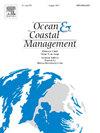评估管理和气候变化情景下沿海和海洋栖息地的累积风险:以葡萄牙北部为例
IF 4.8
2区 环境科学与生态学
Q1 OCEANOGRAPHY
引用次数: 0
摘要
在蓝色增长推动海洋活动扩张的时代,特别是在气候变化影响日益严重的情况下,管理与海洋和沿海地区人类活动和利用相关的风险至关重要。有效管理累积风险对于保护生态系统免受潜在的进一步退化,保持其抵抗力和复原力以及提供生态系统服务和社会产品和效益的能力至关重要。在这里,我们采用基于累积风险的方法来评估栖息地和生态系统的风险,考虑到人类活动和两种气候衍生压力的三种管理叙述,在葡萄牙北部海洋和沿海地区的三条IPCC共享社会经济路径中。我们的研究结果强调了一些海洋地区和沿海地区的高生态系统风险,特别是影响海滩,无光泽的软底和岩石底部以及河口地区。在管理和气候情景中,最重要的风险因素包括海面温度上升、沿海地区相对海平面上升(SLR)和风暴的增加、渔业、旅游业、人工区域和海上运输。总体空间风险格局随管理情景变化的差异大于不同气候情景之间的差异,气候压力对生境和生态系统风险具有累加效应。包括气候衍生的外源压力(即那些其原因来自管理系统之外的压力)改变了陆海界面的高风险区空间格局,而在海洋区域,它增加了总体风险评分,但没有改变观测到的总体风险格局。建议决策者和管理人员采取预防措施,将累积评估纳入决策支持系统和基于生态系统的管理计划,以预测和适应或减轻未来的变化。因此,确保维持生态系统对变化的适应能力,以避免达到可能破坏这些生态系统的资源供应能力以及提供ES和SGB的临界点。本文章由计算机程序翻译,如有差异,请以英文原文为准。
Assessing cumulative risks to coastal and marine habitats under management and climate change scenarios: The case of northern Portugal
Managing the risks associated with human activities and uses in marine and coastal regions is crucial in a time of maritime activity expansion promoted by Blue Growth, especially with the increasing effects of climate change. Effective management of the cumulative risks is essential to safeguard ecosystems from potential further degradation, maintaining their resistance and resilience and ability to provide ecosystem services (ES) and societal goods and benefits (SGB). Here, we adopt a cumulative risk-based approach to assess risk to habitats and ecosystems, considering human activities and two climate-derived pressures for three management narratives, across three IPCC Shared Socioeconomic Pathways in the northern marine and coastal region of Portugal. Our findings highlight high ecosystem risk in some marine areas and coastal segments, particularly affecting beaches, aphotic soft and rock bottoms, and estuarine areas. Across the management and climate scenarios, the most important contributors to risk included rising sea surface temperatures, increased coastal exposure to relative sea-level rise (SLR) and storminess, fishing, tourism, artificial areas, and maritime transport. Overall spatial risk patterns varied more with changes in management scenarios than between climate scenarios, with climate pressures having an additive effect on habitat and ecosystem risk. The inclusion of the climate-derived exogenous pressures (i.e. those whose causes emanate from outside the management system) altered the high-risk zone spatial patterns at the land-sea interface, while in marine areas, it increased the overall risk scores without changing the observed overall risk patterns. It is recommended that policymakers and managers should adopt a precautionary approach, using cumulative assessments integrated into decision-support systems and ecosystem-based management plans to anticipate and adapt to or mitigate future changes. Thereby, ensuring the maintenance of the ecosystem resilience to change, to avoid reaching tipping points that would disrupt the resource-provisioning capacity of these ecosystems and the provision of ES and SGB.
求助全文
通过发布文献求助,成功后即可免费获取论文全文。
去求助
来源期刊

Ocean & Coastal Management
环境科学-海洋学
CiteScore
8.50
自引率
15.20%
发文量
321
审稿时长
60 days
期刊介绍:
Ocean & Coastal Management is the leading international journal dedicated to the study of all aspects of ocean and coastal management from the global to local levels.
We publish rigorously peer-reviewed manuscripts from all disciplines, and inter-/trans-disciplinary and co-designed research, but all submissions must make clear the relevance to management and/or governance issues relevant to the sustainable development and conservation of oceans and coasts.
Comparative studies (from sub-national to trans-national cases, and other management / policy arenas) are encouraged, as are studies that critically assess current management practices and governance approaches. Submissions involving robust analysis, development of theory, and improvement of management practice are especially welcome.
 求助内容:
求助内容: 应助结果提醒方式:
应助结果提醒方式:


